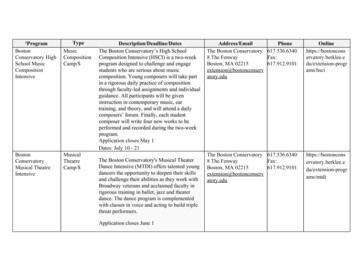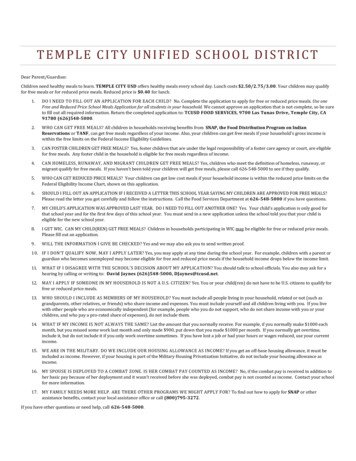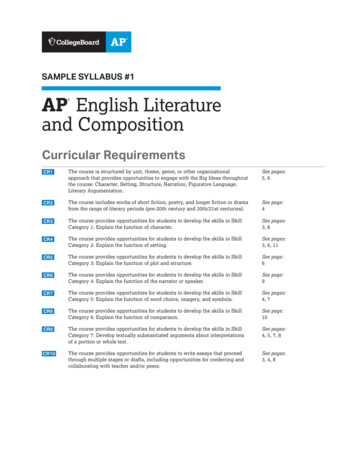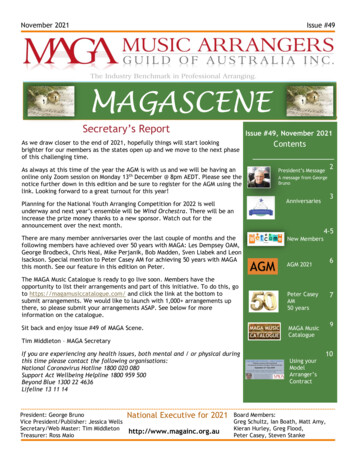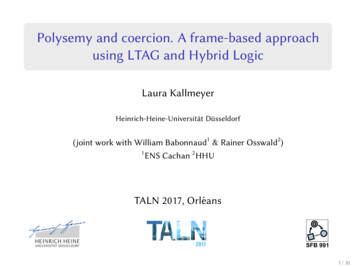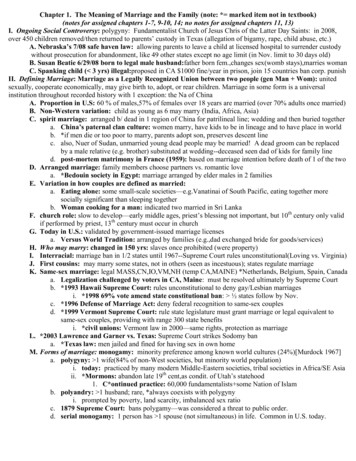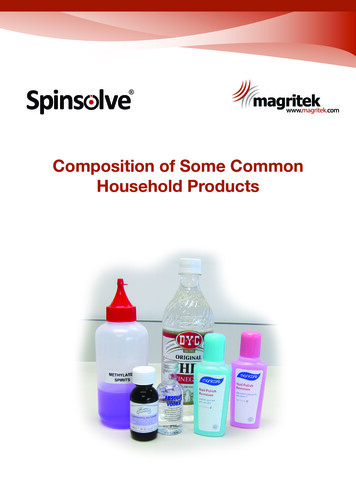
Transcription
RCarbonComposition of Some CommonHousehold ProductsRCarbon1
CarbonContentsObjectives 3Experiment3Safety3Questions3Example Spectra4Acetone4Ethyl Acetate4Ethanol5Acetic Acid5Water6Isopropanol6Nail Polish Remover (pink)7Nail Polish Remover (blue)9Rubbing Alcohol10Vinegar11Vodka12Methylated Spirits13Manuscript prepared by Sarah Moore.RCarbon2
This experiment using the Spinsolve is carried out with final-year high school chemistry students, whodo an analytical instrumentation laboratory course, at RMIT in Melbourne, Australia. This lab manual hasbeen adapted from the material kindly provided by Dr Jeff Hughes such that it is also suitable forundergraduates being introduced to NMR spectroscopy.ObjectivesIn this experiment, students use 1H-NMR spectroscopy to determine the main organic compoundsfound in common household products such as vinegar, nail polish remover and spirits. This is done bycomparing the spectra of household products with spectra of common laboratory solvents.ExperimentYou will be allocated one household product and one reference solvent from the list below. Addapproximately 0.5 mL of each liquid to a 5 mm NMR tube. Measure the 1H-NMR spectrum of each of yoursamples (Quick Scan). Phase your spectra and integrate the peaks. Record the information obtained fromthe NMR spectrum of the reference solvent in a table. In groups of six (one of each household productand reference solvent), identify the organic compounds present in each household product (there may bemore than one). Determine the volume percentage composition of each component.Household product:Reference solvent:Nail polish remover (pink)AcetoneRubbing alcoholEthanolNail polish remover (blue)VinegarVodkaMethylated SpiritsEthyl AcetateAcetic AcidWaterIsopropanolSafety:All of the liquids are highly flammable and should be kept away from heat and open flames. Acetic acid iscorrosive and may cause burns to skin and eye damage.Questions1. By comparing the spectrum of your household product with the reference spectra what compoundscan you identify?2. Does the composition you calculated agree with the label on the bottle? (For products with onecompound, does the bottle specify only one major ingredient?).3. What properties of the compounds you identified make them useful in the product they areincorporated in?RCarbon3
Example SpectraReference solvents1.79Acetone109876543210-1f1 .012.982.003.823.663.493.33Ethyl Acetate0.880.720.56Integration1.48Chemical Shift (ppm)10-1f1 (ppm)Chemical Shift 1.53singlet10.73triplet3RCarbon4
44Ethanol3210-1f1 (ppm)Chemical Shift ic Acid109876543210-1f1 (ppm)Chemical Shift OH1.63singlet1RCarbon5
4.88Water109876543210-1f1 mical Shift (ppm)3210-1f1 (ppm)Chemical Shift H3.61multiplet10.86doublet2RCarbon6
Household Products10987654325.253.006.61Pink Nail Polish Remover10-1f1 (ppm)From the integrals in the spectrum above it is clear that there is more than one compound in the pink nailpolish remover sample. The spectrum has peaks in regions very similar to ethyl acetate, thus the integralof the peak at 1.6 ppm, which appears to be a single compound, was set to 3 (ethyl acetate methyl). Ifone compound is ethyl acetate, the chemical shifts for the other compound(s) is very similar to the ethylchain of ethyl acetate. This, combined with the presence of an exchangeable proton at about 4 ppm,suggests that the other compound is likely ethanol. The exchangeable peak is too large to be a result ofjust ethanol, therefore there is some water in the sample too.In order to confirm the assignments the spectra were superimposed in Mnova below. The splitting ofthe two methylene quartets and methyl triplets of the ethyl chain of ethanol and ethyl acetate are clearlyexplained in this exercise.RCarbon7
Nail polish remover (pink)Ethyl acetateEthanol5.8 5.6 5.4 5.2 5.0 4.8 4.6 4.4 4.2 4.0 3.8 3.6 3.4 3.2 3.0 2.8 2.6 2.4 2.2 2.0 1.8 1.6 1.4 1.2 1.0 0.8 0.6 0.4 0.2 0.0 -0.2 -0.4 -0.6 -0.8 -1.0f1 (ppm)Percentage composition:The singlet at 1.7 ppm corresponds to the methyl adjacent to the carbonyl of ethyl acetate, thus accountsfor three protons. The remaining integrals were normalised using this fact. The other methyl of ethylacetate is more up-field and coincides with the methyl group of ethanol. Because the integrals werenormalised to the singlet at 1.7 ppm, 3 of the 5.25 protons correspond to the methyl of ethyl acetate.Therefore the remaining 2.25 protons are the methyl of ethanol. The methylene peaks and exchangeableprotons all coincide downfield between 4.3 and 2.9 ppm. This includes the methylene group of ethylacetate which accounts for two of the 6.61 protons. In this region there are three protons resulting fromethanol – the methylene and OH, thus ethanol corresponds to 2.25 protons in the integral. The remaining2.36 protons can therefore be attributed to water.IntegralsAssignmentIntegral of 1 proton Mass (g)Volume (mL)% Composition (v/v)--Total 162.71 1006.613.005.25Total2.003.003.00Ethyl acetate .92.3600Water1.1821.2421.2413.1RCarbon8
10987654321.941.481.002.91Blue Nail Polish Remover10-1f1 (ppm)The spectrum of the blue nail polish remover is very similar to that of the pink, but it has an additionalpeak at 1.8 ppm. This is the only additional peak visible in the spectrum. Acetone is the only refrerncesolvent that contains just one peak, threfore the blue nail polish remover contains ethyl acetate, ethanol,water and acetone. This is confirmed by superimposing the spectra below.Nail polish remover (blue)Ethyl 1 (ppm)92.01.51.00.50.0-0.5
Percentage composition:Use similar logic to pink nail polish remover example.IntegralsAssignmentIntegral of 1 proton Mass (g)Volume (mL)% Composition (v/v)1.94 Total--Total 76.95 100000.2514.5218.3623.90.67 01.00 1.00 Ethyl acetate 0.3323.3725.9133.70.63 000.94 Ethanol0.3114.2818.1023.51.61 ubbing Alcohol1.005.054.951.48 00.890.752.91 1.48 13210-1f1 (ppm)The rubbing alcohol appears to contain only one component. The spectrum is identical to that ofisopropanol.IntegralsAssignmentIntegral of 1 proton Mass (g)Volume (mL)% Composition (v/v)--Total 76.4610060.176.461001.031.006.29 Total1.031.006.29 Isopropanol 1RCarbon10
1098762.150.044.952.00Vinegar543210-1f1 (ppm)The NMR spectrum of vinegar contains two peaks. The large peak at 5 ppm must be water. The remainingpeak is a singlet. There are two reference solvents that have an isolated, up-field singlet – acetone andacetic acid. The acetone peak would be expected to appear more more shielded, around 1.5 ppm. Thepeak in the reference solvent of acetic acid is 1.3 ppm, but because acetic acid is an organic acid, thechemical shift will vary with concentration and pH. The same behaviour is not expected for acetone, thusvinegar contains water and acetic acid.Percentage composition:IntegralsAssignmentIntegral of 1 protonMass (g)Volume (mL)% Composition (v/v)2Total--Total 18.631000.013 0.04Acetic acid0.0130.780.744.01.987 0Water0.99417.8917.8996.00.04RCarbon11
.72Vodka3210-1f1 (ppm)The spectrum of vodka appears to be identical to that of ethanol, but the exchangeable proton integratesfor a lot more than 1 so must also contain water.Percentage composition:IntegralsAssignmentIntegral of 1 proton Mass (g)Volume (mL)% Composition (v/v)11.72 23Total--Total 154.87100123Ethanol146.0758.3937.710.72 00Water5.3696.4896.4862.3RCarbon12
87Methylated Spirits3210-1f1 (ppm)The spectrum of methylated spirits is identical to that of ethanol.IntegralsAssignmentIntegral of 1 proton Mass (g)Volume (mL)% Composition (v/v)1.071.983.00 Total--Total 58.391001.071.983.00 Ethanol146.0758.39100RCarbon13
RUse the Spinsolve benchtop NMRspectrometer to enhance the teachingexperience in a chemistry laboratoryor classroom.Why the Spinsolve will suit your education needs: REDUCE COST Low cost to purchase compared to high field. Non-deuterated solvents can be used. Low power consumption. Budget NMR tubes can be used.SAVE TIME Nearby - fits easily on laboratory bench. Standard 5 mm NMR tubes enables rapid sampleexchange. Fast - students get on and off quickly. Easy to use - simple and intuitive software. Safe - no stray magnetic field.INFORMATIVE Enables leading NMR education. Obtain high-resolution NMR data in as little as 10 seconds. Now available with 2D, multi-pulse experiments (2DJRes, COSY) and 19F Fluorine. Students and teaching staff gain hands-on experience with NMR.CONTACT INFORMATIONFor further information, please contact: sales@magritek.comGERMANYNEW ZEALANDPhilipsstraße 852068 Aachen, GermanyTel: 49 (241) 70525-6000Fax: 49 (241) 963 1429Or visit our Rwebsite www.magritek.comCarbon6 Hurring Place, Unit 3Newlands, Wellington 6037, NZTel: 64 4 477 7096Fax: 64 4 471 4665UNITED STATES6440 Lusk Blvd (D108)San Diego, CA 92121, USATel: 1 (855) 667-6835 1 (866) NMR-MTEK
The remaining integrals were normalised using this fact. The other methyl of ethyl acetate is more up-field and coincides with the methyl group of ethanol. Because the integrals were normalised to the singlet at 1.7 ppm, 3 of the 5.25 protons correspond to the methyl of ethyl acetate. Therefore the remaining 2.25 protons are the methyl of ethanol.

